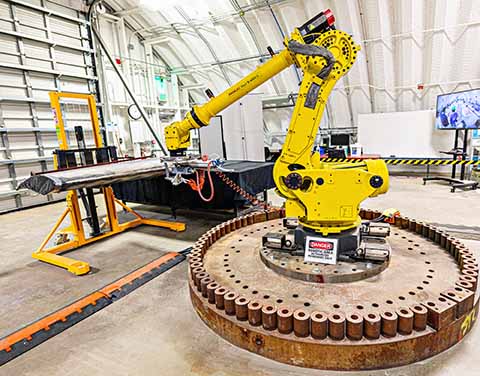Engaging Autopilot: NREL Explores Automation To Build Better Blades, Lower Costs, and Transform Wind Technology Manufacturing

In the world of utility-scale wind turbines, bigger blades are better. And yet, the production of these massive structures—the largest dynamic, rotating machines in the world—can pose engineering and manufacturing challenges. Targeted automated solutions can help overcome some of these challenges.
For instance, when a wind turbine blade is removed from a mold, it must be trimmed, sanded, and shaped to certain specifications to meet aerodynamic tolerances.
“If you go to a blade manufacturing plant and watch the process, it’s very labor intensive,” said National Renewable Energy Laboratory (NREL) Research Engineer Casey Nichols. “As blades get bigger, it takes more and more people to produce the blades, dressed in Tyvek suits and using grinders to finish the blade into the right shape.”
Processes like these are some of the most difficult for blade manufacturing workers, and they are also the processes that could benefit most from targeted automation, according to NREL Senior Wind Technology Engineer Derek Berry.
“And, as wind turbine blades become longer, so too do other blade dimensions such as widths and also height due to blade curvature. These trends result in ever-increasing work at higher heights in blade factories, which is more dangerous, more difficult, more time-intensive, and more costly,” Berry said.
Berry and a team of NREL researchers are exploring the targeted automation of wind turbine blade finishing to help mitigate these challenges while increasing worker safety and the quality of the finished blade structure. The work is part of a partnership with General Electric Renewables/LM Wind Power, the Institute for Advanced Composites Manufacturing Innovation, and the U.S. Department of Energy Advanced Manufacturing Office.
For three decades, automation in the wind blade manufacturing industry has proved elusive.
“Many in the wind energy industry believe that we’ll be left behind if we don’t more fully incorporate automation into U.S. wind blade manufacturing,” Berry said. “We’ve been trying to understand where automation can fit into the manufacturing process, but capital equipment is expensive and automated solutions can often be slower than what humans can do.”
Among many others, Berry and his colleagues see automation in manufacturing as a means of improving both the quality of turbine blades being manufactured and their reliability in the field. Improved automation could also help to bring down manufacturing costs while increasing its speed and utilization factor.
Working at NREL's Composites Manufacturing Education and Technology (CoMET) Facility, the NREL team is prototyping and validating innovative blade-finishing technologies.
To aid in this research, NREL installed a robot with a 3-meter arm equipped with several prototype devices called end effectors that can perform various blade finishing operations. And thanks to support from the Colorado Office of Economic Development and International Trade, a second robot is expected to arrive at the CoMET Facility in fall 2021. This robot will provide a larger platform for automation research, expanding NREL’s capabilities for researching blade-finishing technologies.
Another aspect of NREL’s automation research involves using 3D-imaging technologies to capture the geometry of the blade surface in the factory and program the robot movements to finish the blade. This capability allows for detailed in situ location of the aerodynamic exterior of the blade, which enables more accurate trimming and shaping by the automated system. Ultimately, this will result in more accurate blade airfoil shapes deployed in the field, resulting in increased aerodynamic performance.
Their work is just beginning. Armed with automated equipment, 3D technologies, and advanced manufacturing expertise, NREL and its partners are finding ways to build bigger, better blades at possibly lower costs.
Learn more about NREL’s advanced manufacturing and wind energy research, and explore the CoMET capabilities.
Last Updated May 28, 2025
